Zubeneschamali, Beta Librae (β Lib), is a blue-white main sequence star located in the constellation Libra. With an apparent magnitude of 2.61, it is the brightest star in Libra, only barely outshining its neighbour Zubenelgenubi (Alpha Librae). Zubeneschamali lies at a distance of 185 light years from Earth.
Star type
Zubeneschamali is a hot blue hydrogen-fusing star of the spectral type B8 V. It has a mass 3.5 times that of the Sun and a radius 4.9 times solar. The radius is derived from the star’s angular diameter, measured at 0.801 milliarcseconds in 2009. With an effective temperature of 12,300 K, Zubeneschamali shines with 130 solar luminosities.
The star is a very fast spinner, with a projected rotational velocity of 250 km/s. Its estimated age is about 80 million years.
Zubeneschamali is a suspected variable, showing brightness variations with an amplitude of 0.3 magnitudes. It has been suggested that the variations are caused by the presence of a smaller companion, but one has never been detected around the star and, for this reason, Beta Librae is classified as a single star.
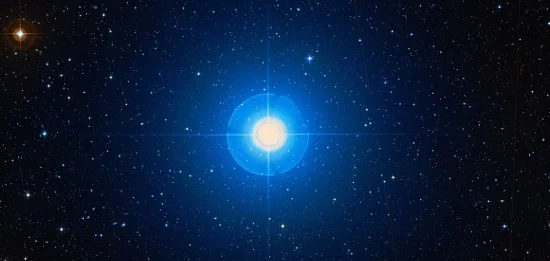
Zubeneschamali (Beta Librae), image: Wikisky
Facts
With an apparent magnitude of 2.61, Zubeneschamali narrowly misses making the list of the 100 brightest stars. On average, it is the 102nd brightest star in the sky. It is only slightly fainter than Arneb in the constellation Lepus, Delta Centauri in Centaurus, Gienah in Corvus, and Ascella in Sagittarius, and it just outshines Unukalhai in Serpens, Sheratan in Aries, Zubenelgenubi in Libra, and Phact in Columba.
Zubeneschamali may have once been considerably brighter. The Greek astronomer Eratosthenes (c. 276 BCE – c. 195/194 BCE) noted that the star was brighter than Antares and every other star in Scorpius and Claws (Libra represented the claws of Scorpius at the time). Claudius Ptolemy (c. 100 CE – c 170 CE) said that the two stars – Zubeneschamali and Antares – were equally bright. It is uncertain whether Zubeneschamali was really that much brighter than it is now or if Antares was fainter and later brightened to first magnitude. Today, even at its faintest Antares is a full magnitude brighter than Zubeneschamali.
Name
The name Zubeneschamali (pronunciation: /ˌzuːbənˌɛʃəˈmeɪli/) is derived from the Arabic al-zubānā al-šamāliyy, meaning “the northern claw.” It has also been spelled Zuben Eschamali, Zubenelschemali, Zubenesch, Zuben el Chamali, and Zubenelg. In early Greek astronomy, Libra stars represented the Chelae, the claws of Scorpius, and the name refers to the star’s position in Scorpius. The southern claw of the scorpion was represented by Zubenelgenubi, Libra’s second brightest star.
The name Zubeneschamali was approved by the International Astronomical Union’s (IAU) Working Group on Star Names (WGSN) on August 21, 2016.
Beta Librae was also known as Kiffa Borealis, which comes from the Arabic al-kiffah aš-šamāliyy, meaning “the pan (of the scales),” and the Latin borealis, meaning “northern.” The name was translated into Latin as Lanx Borealis or Lanx Septentrionalis. (Septentrionalis is another word for “northern.”) The Italian astronomer Riccioli called the star Vazneschemali, meaning “the northern weight.”
In Chinese astronomy, Beta Librae is known as 氐宿四 (Dī Xiù sì), the Fourth Star of Root. The Chinese Root asterism is formed by Zubeneschamali with Zubenelgenubi (Alpha2 Librae), Iota1 Librae, and Zubenelhakrabi (Gamma Librae). The asterism is one of the eastern mansions of the Azure Dragon. It represents the Dragon’s chest.
Location
Zubeneschamali is easy to find because, along with its neighbour Zubenelgenubi, “the southern claw,” it lies next to the claws of Scorpius, formed by Acrab, Dschubba, and Fang. Libra’s two brightest stars appear as the extended claws of the scorpion.
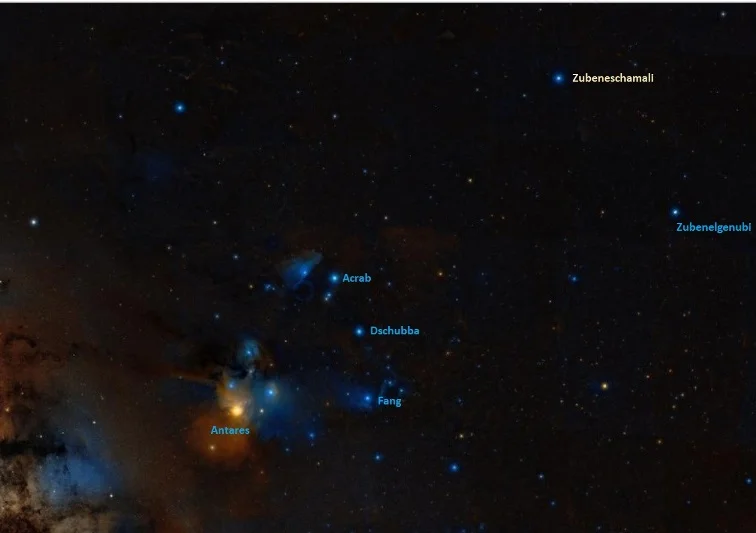
Zubeneschamali location, image: Wikisky
Zubeneschamali lies close to the celestial equator and is visible from all inhabited areas for at least a part of the year. The best time of year to observe the star is in the evening during the month of June.
Zubeneschamali can be used to find the magnitude 11.2 elliptical galaxy NGC 5812. The galaxy lies about halfway between Beta Librae and Mu Virginis.
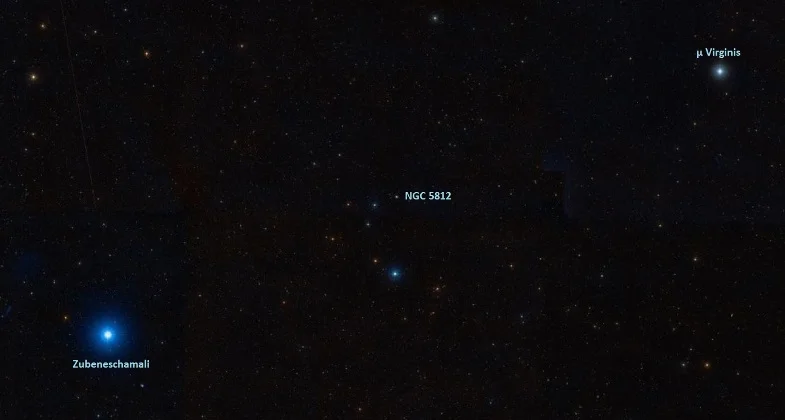
Zubeneschamali and NGC 5812, image: Wikisky
The face-on spiral galaxy NGC 5885 appears a bit closer to Zubeneschamali. It lies just south-southwest of the star.
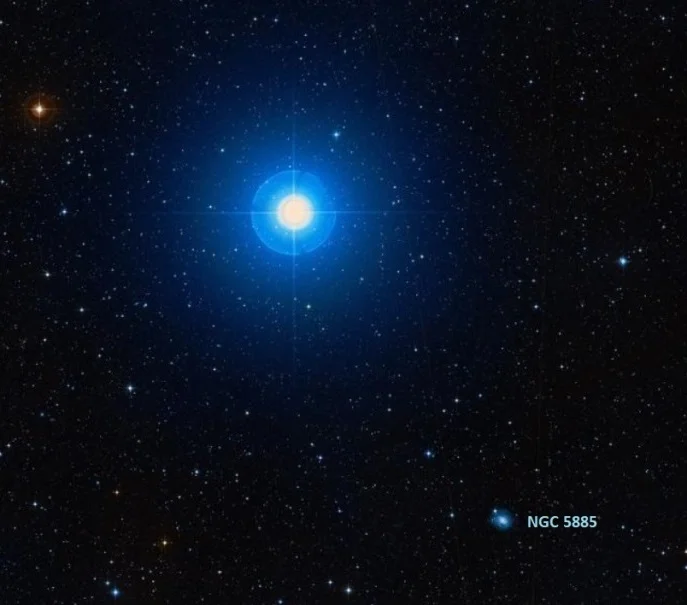
Zubeneschamali and NGC 5885, image: Wikisky
Constellation
Zubeneschamali is located in the constellation Libra. Libra occupies 538 square degrees between the fellow zodiac constellations Scorpius and Virgo and is the 29th largest of all 88 constellations. It is one of the 48 Greek constellations, first listed by Claudius Ptolemy of Alexandria in his Almagest in the 2nd century CE.
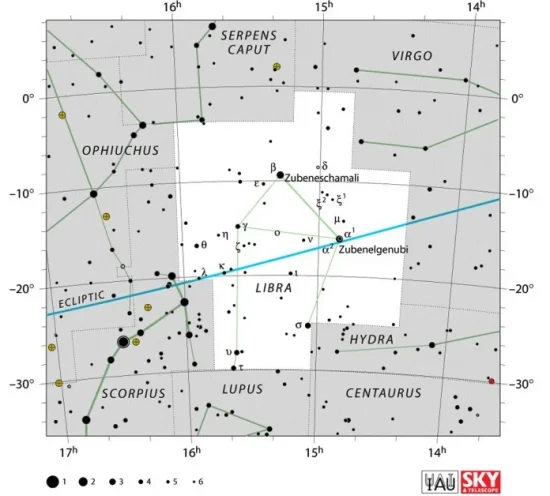
Libra constellation map by IAU and Sky&Telescope magazine
Libra is not very prominent in the sky, with only two stars – Zubeneschamali and Zubenelgenubi – brighter than magnitude 3.00. The constellation’s two brightest stars represent the balance beam of the celestial scales, while the fainter Zubenelhakrabi (Gamma Librae) and Brachium (Sigma Librae) mark the weighing pans.
Libra is home to several notable stars. These include the multiple star system Iota1 Librae, the Algol variable Delta Librae, the subgiant HD 140283, nicknamed the Methuselah star, one of the oldest stars known with an estimated age of 14.46 billion years, and Gliese 581, a red dwarf located 20.56 light years away that hosts at least three exoplanets, including Gliese 581c, the first Earth-like planet discovered in its host star’s habitable zone.
Deep sky objects in Libra include the relatively bright and large globular cluster NGC 5897 and the barred spiral galaxies NGC 5885 and NGC 5792.
The best time of year to see the stars and deep sky objects in Libra is during the month of June, when the constellation rises high in the evening sky. The entire constellation is visible from locations between the latitudes 65° N and -90° S.
The 10 brightest stars in Libra are Zubeneschamali (Beta Lib, mag. 2.61), Zubenelgenubi (Alpha Lib, mag. 2.741), Brachium (Sigma Lib, mag. 3.29), Upsilon Librae (mag. 3.628), Tau Librae (mag. 3.68), Zubenelhakrabi (Gamma Lib, mag. 3.91), Theta Librae (mag. 4.136), 16 Librae (mag. 4.49), Iota1 Librae (mag. 4.54), and 37 Librae (mag. 4.61).
Zubeneschamali – Beta Librae
| Spectral class | B8 V |
| Variable type | Suspected |
| U-B colour index | −0.359 |
| B-V colour index | −0.106 |
| Apparent magnitude | 2.61 |
| Absolute magnitude | -1.16 |
| Distance | 185 ± 2 light years (56.8 ± 0.5 parsecs) |
| Parallax | 17.62 ± 0.16 mas |
| Radial velocity | -35.60 ± 1.8 km/s |
| Proper motion | RA: −98.10 mas/yr |
| Dec.: −19.65 mas/yr | |
| Mass | 3.5 (3.3 – 3.8) M☉ |
| Luminosity | 130 L☉ |
| Radius | 4.9 R☉ |
| Temperature | 12,300 K |
| Metallicity | 0.33 dex |
| Age | 80 million years (40 – 130 million years) |
| Rotational velocity | 250 km/s |
| Constellation | Libra |
| Right ascension | 15h 17m 00.41382s |
| Declination | −09° 22′ 58.4919″ |
| Names and designations | Zubeneschamali, Beta Librae, β Lib, 27 Librae, HD 135742, HR 5685, HIP 74785, FK5 564, PPM 198424, BD-08° 3935, GC 20539, GCRV 8838, SAO 140430, NSV 7009, PLX 3450.00, JP11 2586, IRAS 15142-0911, 2MASS J15170043-0922584, UBV 13171, TYC 5585-1014-1, GSC 05585-01014, WISE J151700.43-092258.9 |